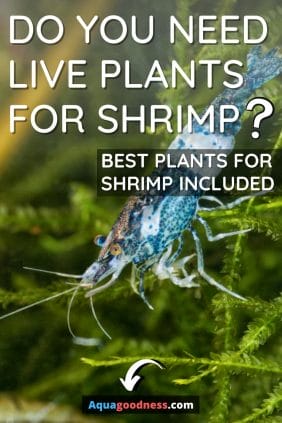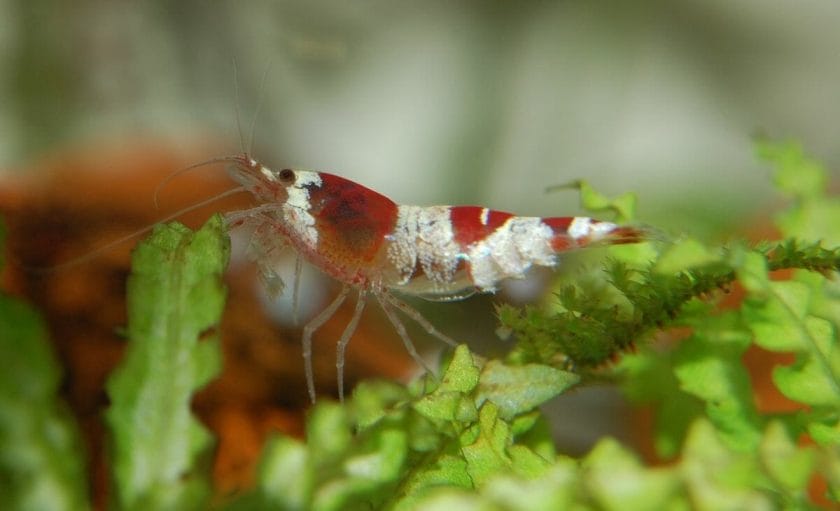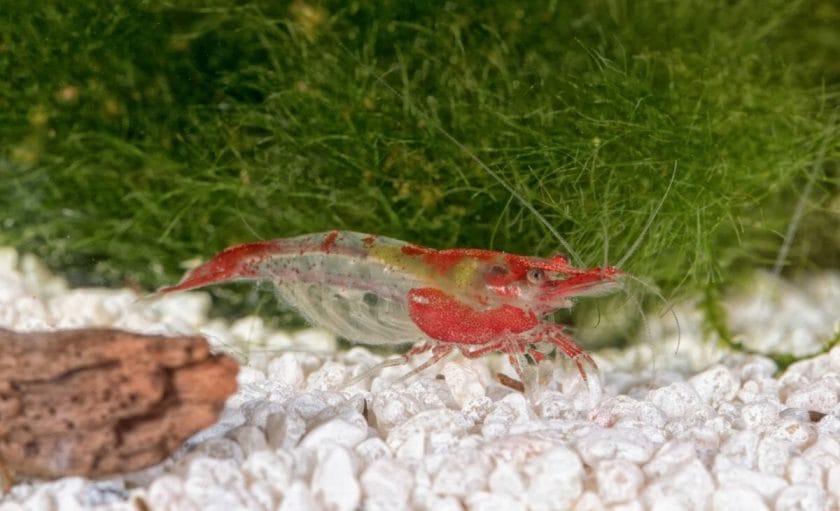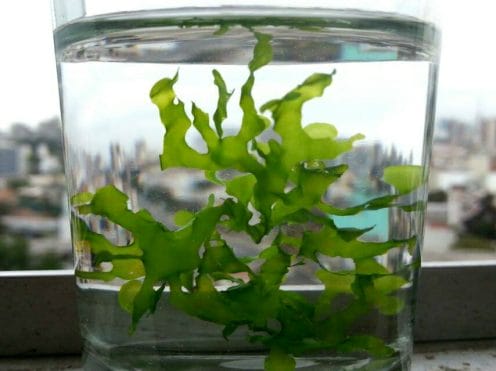So you’ve got yourself some new shrimp. Now you may be wondering whether you need live plants to keep them happy and healthy.
Live plants aren’t necessary for a shrimp tank, but it’s advisable to include them in your tank setup in order to maintain ideal tank conditions, give shrimp a place to hide, and provide them with food in the form of biofilm.
Keep reading to discover how live plants benefit your shrimp and how they can help your aquarium thrive.

Table of Contents
Are Live Plants Important for Shrimp Tanks?

Live plants are a great addition to most tanks and something that most practiced aquarists would recommend in a heartbeat. Live plants are not necessary for shrimp tanks, but they do come highly recommended.
You’ll have a much easier time caring for your shrimp and giving them a good quality of life if you include live plants in your tank.
Plants Help Keep Conditions Stable
The most important role that plants serve in a tank is helping to bring the ecosystem more into alignment with a natural environment.
Put simply, plants keep your tank conditions stable by serving various functions.
Reducing Algae
Live plants and algae rely on the same nutrients as food sources, and as such, live plants can outcompete algae for resources, cutting back on the algae population.
Of course, live plants will not outcompete an algae bloom if the conditions in the tank are ripe for algae growth, but they do serve as an effective safeguard against the all too unpleasant green film we associate with algae.
Adding Filtration
Aquariums need filtration, and live plants help to filter out decaying matter, ammonia, nitrites, nitrates, and carbon dioxide from the water.
As such, live plants can help you avoid a buildup of toxic substances in your tank. In case you’re wondering, a solely live plant filtered tank is possible, but it’s not an easy cycle to set up, and as a beginner, you should always opt for a filter to do the heavy lifting while your plants supplement the filtration process.
Oxygenating Your Tank
Another important function of live plants is oxygenation. The photosynthesis process involves an intake of carbon dioxide and expulsion of oxygen.
This process is helpful twofold in your tank since it removes harmful carbon dioxide and pumps much needed oxygen into your tank.
As a recap, fish do not ‘breathe’ the water itself; instead, their gills extract oxygen in a process that requires pressure from the water to work. That’s why oxygen rich water is so important for fish.
Without it, they can be susceptible to illness and lethargy. Generally, your filter will do most of the work in providing the necessary surface movement that facilitates the oxygen exchange, but you can feel free to add a couple of airstones to prompt more oxygenation.
Shrimp don’t particularly need a heavily oxygenated tank; in fact, too much current from a too-powerful filter can be disruptive for such sensitive creatures.
If you have a nano-tank (2 gallons or smaller) or a shrimp-only tank, a tiny sponge filter is more than enough to take care of your oxygenation needs, although live plants are always a boon to a tank.
On the other hand, a community tank that features fish and shrimp may benefit from live plants for their oxygenation.
Making the Tank Environment More Natural
One factor of aquariums that many hobbyists, especially beginners, tend to forget is that tanks need to mimic their wild counterparts to make the inhabitants happy.
Live plants are excellent natural cover for shrimps, who are the prey of many aquatic creatures.
Giving shrimp somewhere to hide will reduce stress, and many shrimp will also do you the service of clearing algae film from live plants, too.
You can also add driftwood, coconut husks, or tunnels to add more places for shrimp to hide. Even in a shrimp-only tank, they’ll thank you for the security. Besides, live plants, wood, and other natural decorations add intrigue and variety to a tank, making it more unique.
If your goal is to have your shrimp breed, then good quality tank conditions (i.e., ideal water parameters, plentiful food, and hiding places) will encourage the process.
Of course, in all honesty, you don’t need to nudge shrimp to breed; unless your tank conditions are extremely poor, they’ll breed all the same.
The Downsides of Having Live Plants in Your Tank

There aren’t many negatives to having live plants in your tank. It might be better to think of them as “before you buy” precautions.
Some Plants Are Easier to Care for than Others
First and foremost, you should put some thought into what aquarium plants you choose.
Some are much easier to care for than others; for example, I’ve had great success with Amazon Sword, Crypt Wendtii, and Anubis. They’re super simple to care for since they can adapt to different lighting and temperature conditions, and they look great!
The hardier the plant, the easier they are to care for, and choosing plants that provide ideal hiding places for shrimp, while also looking amazing, is important.
Plants like the cabomba furcate, for example, require in-depth plant knowledge, including the proper lighting arrangement and fertilization. They look beautiful, of course, but they can be challenging to keep alive, especially if you’re new to the fishkeeping hobby.
Plants Can Carry Diseases
It should come as no surprise that, even if you trust the seller, plants can carry a host of fungal and bacterial diseases that can harm your tank. Plants can also come with smuggled snail eggs if they aren’t thoroughly examined.
Shipped plants may also be harboring a bunch of algae. Each of these concerns can be addressed by disinfecting your plants before introducing them to the tank.
Place the plants in potassium permanganate for 10 minutes to kill off harmful diseases, an alum bath for 1-2 days, and a bleach solution of 1 part bleach to 20 parts water for 2 minutes if you spot algae.
Shrimp Will Nibble Your Plants
Both shrimp and some omnivorous fish will nibble your plants. It’s certainly not a dealbreaker, but it’s a good reminder to keep your feeding schedule consistent and varied so that your tank inhabitants don’t take to chewing your beautiful live plants.
Can You Keep Shrimp with Fake Plants?

You can certainly keep shrimp with fake plants without any detriment to their health. Artificial plants are much easier to care for, obviously, since they aren’t subject to changes in the tank condition.
On the other hand, fake plants don’t offer any benefits in regulating the tank conditions or removing waste. If there’s one defining feature of shrimp, it’s their sensitivity to change.
In order to keep shrimp healthy, you need to offer them consistent, stable tank conditions. That’s certainly possible in a tank with just artificial plants and a suitable sponge filter, but live plants can help–they certainly never hurt!
Best Beginner Live Plants for Shrimp Tanks
Below are some of the best aquarium plants for shrimp. These are hardy and easy to care for aquarium plants so they are ideal for beginners.
Java Moss
| Difficulty | Super easy |
| Lighting Requirements | Low to medium light |
| pH | 5-9 |
| Temperature | 60-90°F |
| Height | 2-4 inches |
Java Moss is amazing. It attaches to just about anything, and it’s super easy to care for. It’s also an excellent hiding spot for shrimp and their fry, making it not only a great look for your tank but also a functional part of the shrimp’s quality of life.
Buy from Amazon here
Anubias
| Difficulty | Super easy |
| Lighting Requirements | Low |
| pH | 5-8 |
| Temperature | 71-78°F |
| Height | 10-18 inches |
Anubias is a great plant that doesn’t demand much attention, proving to be extremely hardy and adaptable to many different lighting and temperature conditions.
The attractive broad shape of the leaves makes it a great aquascaping tool and makes for a great place where shrimp can hide.
Buy from Amazon here
Java Fern
| Difficulty | Easy |
| Lighting Requirements | Low to medium |
| pH | 6-8 |
| Temperature | 68-82°F |
| Height | 6-13 inches |
Java Fern adds a beautiful splash of green to your tank and works best when attached to wood or other objects. It doesn’t require ideal lighting, temperature, or substrate, so it’s really hard to kill.
The broad leaves and natural encouragement of biofilm are both great for your shrimp in a tank.
Buy from Amazon here
Subwassertang

Photo by Rǫgn under CC BY-SA 4.0
| Difficulty | Easy |
| Lighting Requirements | Low to medium |
| pH | 6-8 |
| Temperature | 68-73°F |
| Height | 4 inches per year |
Subwassertang is a great shrimp plant for beginners because it can thrive in a wide range of conditions. In addition, it’s a great breeding and feeding ground for both shrimp and shrimp fry.
Pearl Weed
| Difficulty | Easy |
| Lighting Requirements | Medium |
| pH | 6.3-7.2 |
| Temperature | 66-82°F |
| Height | 6 inches |
Pearl weed is a gorgeous plant that can add some color to your tank and provide excellent space for shrimp. Slow and steady, the pearl weed is a great compatible plant for nano tanks.
The only difference to remember about pearl weed is that, unlike the others on this list, it requires a nutrient rich substrate for best results.
If you want to prompt faster growth for your Pearl Weed, you can supplement it with CO2.
Buy from Amazon here
FAQs

Are Freshwater Shrimp Good for Small Aquariums?
Freshwater shrimp do excellently in nano-tanks, tanks that are 2 gallons or smaller, since they don’t contribute a lot of waste and don’t require a lot of space to thrive.
Keeping a small tank with shrimp-only is generally best, however, because fish can heavily impact the bioload.
What Is the Best Plant for a Shrimp Tank?
Java moss is the best plant for a shrimp tank. Not only does it create the perfect ‘turf’ for shrimp to sift through, but it’s an excellent breeding ground favored by shrimp breeders around the world.
Java moss is super simple to care for and can attach to just about any surface, making it hardy, versatile, and perfect for shrimp.
Why Do Shrimp Eat Live Plants?
Shrimp are scavenger omnivores, meaning they’ll eat just about anything they can, plants included. Not only will shrimp nibble on plants, they’ll also feed on the biofilm that the plants produce.
Conclusion
Shrimp make for colorful, active additions to any freshwater tank, but it’s important to accommodate them with the right plant life for the best quality of life.
Artificial plants can be used in a shrimp tank, but you might have to take additional steps to ensure your shrimp are happy and healthy.
Make sure you refer to the above handy guide to beginner live plants to add some greenery to your tank and keep your shrimp in good shape!



